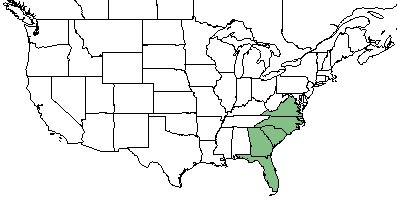Difference between revisions of "Sagittaria graminea"
(→Conservation and Management) |
|||
| Line 43: | Line 43: | ||
<!--==Diseases and parasites==--> | <!--==Diseases and parasites==--> | ||
| − | ==Conservation and | + | ==Conservation, cultivation, and restoration== |
''S. graminea'' is listed as threatened by the Kentucky State Nature Preserves Commission and the Tennessee Department of Environment and Conservation Natural Heritage Program, as endangered by the Ohio Department of Natural Resources Division of Natural Areas and Preserves, as a special concern species by the Rhode Island Department of Environmental Management, and as a noxious weed by the Washington Administrative Code.<ref name= "USDA Plant Database"/> | ''S. graminea'' is listed as threatened by the Kentucky State Nature Preserves Commission and the Tennessee Department of Environment and Conservation Natural Heritage Program, as endangered by the Ohio Department of Natural Resources Division of Natural Areas and Preserves, as a special concern species by the Rhode Island Department of Environmental Management, and as a noxious weed by the Washington Administrative Code.<ref name= "USDA Plant Database"/> | ||
| − | == | + | ==Cultural use== |
| + | |||
==Photo Gallery== | ==Photo Gallery== | ||
<gallery widths=180px> | <gallery widths=180px> | ||
</gallery> | </gallery> | ||
==References and notes== | ==References and notes== | ||
Revision as of 12:15, 9 June 2021
Common name: grassy arrowhead [1]
| Sagittaria graminea | |
|---|---|

| |
| Photo by John Bradford hosted at Bluemelon.com/poaceae | |
| Scientific classification | |
| Kingdom: | Plantae |
| Division: | Magnoliophyta - Flowering plants |
| Class: | Liliopsida - Moncots |
| Order: | Alismatales |
| Family: | Alismataceae |
| Genus: | Sagittaria |
| Species: | S. graminea |
| Binomial name | |
| Alismatales Michx. | |

| |
| Natural range of Sagittaria graminea from USDA NRCS Plants Database. | |
Contents
Taxonomic Notes
Synonyms: S. graminea Michaux var. graminea; S. graminea ssp. graminea; S. eatonii J.G. Smith; S. cycloptera (J.G. Smith) C. Mohr
Varieties: none
Description
S. graminea is a perennial forb/herb of the Alismataceae family native to North America.[1]
Distribution
S. graminea is found in Florida, Georgia, South Carolina, North Carolina, and Virginia.[1]
Ecology
Habitat
S. graminea proliferates in marshes, ponds, freshwater and oligohaline tidal marshes.[2] Specimens have been collected from shallow drying ponds, wooded floodplain, basin swamp. swampy flatwoods, and mixed hardwood forest.[3]
Phenology
S. graminea has been observed to flower February through July.[4]
Conservation, cultivation, and restoration
S. graminea is listed as threatened by the Kentucky State Nature Preserves Commission and the Tennessee Department of Environment and Conservation Natural Heritage Program, as endangered by the Ohio Department of Natural Resources Division of Natural Areas and Preserves, as a special concern species by the Rhode Island Department of Environmental Management, and as a noxious weed by the Washington Administrative Code.[1]
Cultural use
Photo Gallery
References and notes
- ↑ 1.0 1.1 1.2 1.3 USDA Plant Database https://plants.usda.gov/core/profile?symbol=SAGRW
- ↑ Weakley, A. S. (2015). Flora of the Southern and Mid-Atlantic States. Chapel Hill, NC, University of North Carolina Herbarium.
- ↑ URL: http://herbarium.bio.fsu.edu. Last accessed: June 2018. Collectors: P.L. Redfearn, R.F. Doren, R.K. Godfrey, R.Komarek, Rodie White, Leon Neel, R.A. Norris, Loran Anderson, T. MacClendon, K. MacClendon, M. Darst, A. Stiles, H. Light, L. Peed, Jean Wooten, Preston Adams. States and counties: Florida (Leon, Washington, Jackson, Calhoun, Wakulla, Franklin, Calhoun, Levy)
- ↑ Nelson, G. PanFlora: Plant data for the eastern United States with emphasis on the Southeastern Coastal Plains, Florida, and the Florida Panhandle. www.gilnelson.com/PanFlora/ Accessed: 29 MAY 2018